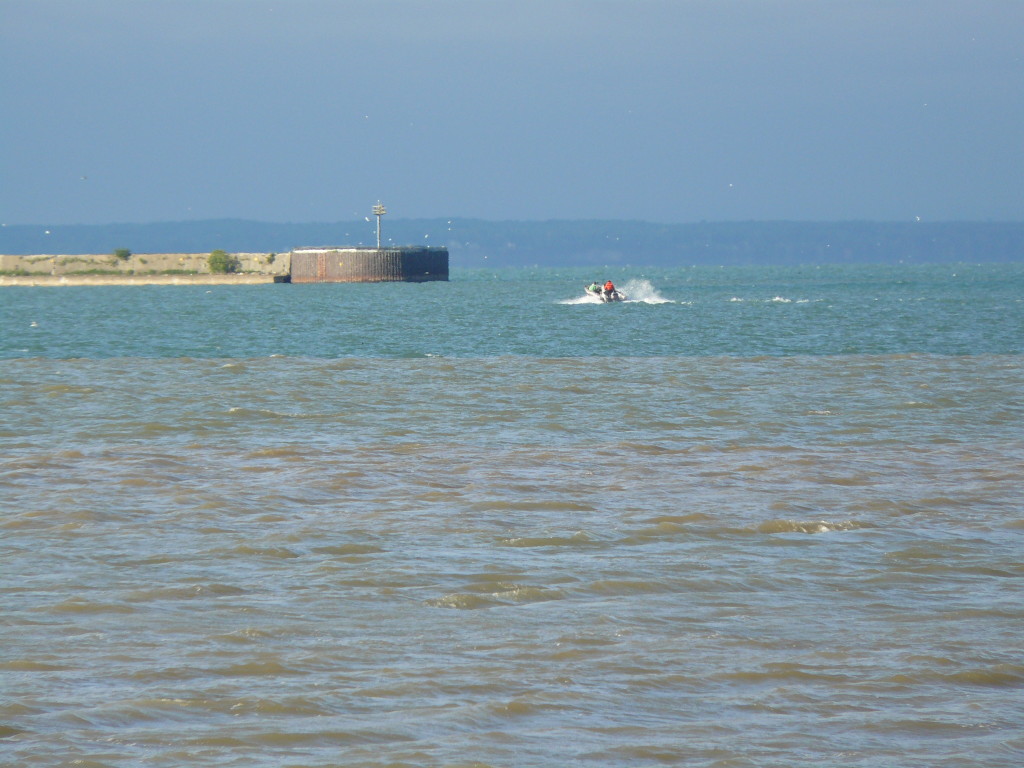Jun 11
2013
Ugly month for sewer overflows in Erie County

For the first time, the numbers are flowing in on sewer overflows across the state and it isn’t pretty.
In Erie County, almost 7 million gallons of untreated sewage were discharged into local waterways in May.
This information wasn’t publicly available on the Internet until the Sewage Pollution Right to Know Law went into effect last month.

A recent sewer overflow in Black Rock Canal near Lasalle Park in Buffalo turns the water brown. (Photo courtesy of Buffalo-Niagara Riverkeeper)
Based on what’s reported so far, the biggest repositories of raw sewage were Ellicott Creek (2 million gallons), Scajaquada Creek (1 million) and the Niagara River (679,000). Heavy rain or snow melt is often the cause of these overflows. The ground water seeps through cracks in the sewer pipes or enters the sanitary sewer system through footing drains, sump pumps or improperly connected downspouts.
These overflows have a huge impact on water quality because they typically include untreated human and industrial waste, toxic materials and debris.
The sanitary sewer overflow estimates on a spreadsheet from the state Department of Environmental Conservation are conservative because some of the plant operators aren’t filling out overflow estimates and it doesn’t include “combined sewer overflows,” which is the type of system in Buffalo.
In total, 6,745,400 gallons of sanitary sewer overflow are reported for May in Erie County.
Of the 77 discharges reported on the DEC list, 24 came from Erie and Niagara counties.
The DEC is still working on a plan to report combined sewer overflows.
Combined sewer systems, such as the one in Buffalo, take both raw sewage and untreated stormwater into one pipe that delivers it to a wastewater treatment facility. These types of systems exist in about 700 cities. Instead of being treated at a plant, raw sewage is discharged into waterways during storm events.
According to the DEC, most large municipal sewer systems in New York have combined sewers in urban areas and separate sanitary and storm sewers for the suburbs. For Google Earth users, the DEC has mapped of the combined sewer overflow discharge points across the state.
Read this 2011 report from Buffalo-Niagara Riverkeeper for more information on Buffalo’s system. The report puts into perspective the impacts these overflows have on water quality and promotes green infrastructure solutions.
For example, Riverkeeper collected water samples to test for E. coli at Scajaquada Creek in the eastern portion of Delaware Park. Of the 28 samples, only three passed federal standards for safe swimming. Six actually exceeded the testable maximums for E. coli.
The report also highlights how sewage contamination in Scajaquada Creek was believed to be the chief culprit for botulism outbreaks in wildlife dating to the 1970s and as recently as 2001. This resulted in the DEC issuing an emergency order for the Buffalo Sewer Authority to remove contaminated sediment from the creek. But the work never performed because the removal proved to be too costly, according to the report.
The federal Environmental Protection Agency and the DEC are trying to end these overflows, but it will be a slow process that will cost hundreds of millions of dollars, and possibly more, in this region alone.
Here’s a list of the sewer overflows:
- Hamburg, Electric Avenue Pump Station, unknown amount, May 10.
- Niagara County, Rainbow Bridge Outfall 694 gallons into Niagara River, May 13.
- Niagara County, West Riverhop Drive Bypass Station, unreported amount into Niagara River, May 28.
- Hamburg, 3859 Robin Lane at Big Tree Road, unreported amont, May 28.
- Hamburg, Electric Avenue Pump Station, unreported amount, May 28.
- West Seneca, Elmsford Drive Pump Station, 924,000 gallons into unknown creek, May 28.
- Cheektowaga, Union Road/Ellen Drive, unreported amount into Ellicott Creek, May 28.
- City of Tonawanda, Fuller Avenue Pump Station, 880,000 gallons into Ellicott Creek, May 28.
- Cheektowaga, Vern Lane/Joanne Drive, unreported amount into Cayuga Creek, May 28.
- Niagara County, Luick Lift Pump Station, 9,000 gallons into Niagara River, May 28.
- Town of Grand Island, 1490 E. River Rd., 348,700 gallons into Niagara River, May 28.
- City of Tonawanda, Luksin Pump Station, 37,500 gallons into Mill Creek, May 28.
- City of Tonawanda, Fillmore Avenue Pump Station, 40,000 gallons into Ellicott Creek, May 28.
- West Seneca, Elmsford Drive Pump Station, 1,953,600 gallons “sanitary to surface water,” May 28.
- Southtowns AWT, Hamburg, 5018 Richmond Ave., unreported amount, May 28.
- Hamburg, Electric Avenue Pump Station, unknown amount, May 28.
- Town of Cheektowaga, 489 Roycroft Boulevard, 1 million gallons into Scajaquada Creek, May 28.
- Niagara County, Rainbow Bridge Outfall, unknown amount, May 28.
- West Seneca, Elmsford Drive Pump Station, 156,000 gallons, May 28.
- Southtowns Sewage Treatment Plant, 3690 Lakeshore Rd, 254,000 gallons partially treated with disinfectant into unknown location, May 29.
- Blasdell, Labelle Avenue Pump Station, 6,300 gallons, May 29.
- City of Tonawanda, Young Street Pump Station, 333,000 gallons into Ellicott Creek, May 29.
- City of Tonawanda, Fuller Avenue Pump Station, 840,000 gallons into Ellicott Creek, May 29.
- City of Tonawanda, Franklin and Fletcher, 321,000 gallons into Niagara River, May 29.
